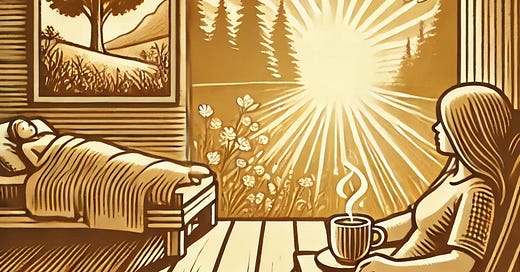Yesterday, I couldn’t show up to full capacity for the 100 Days of Community—I just didn’t have it in me. My body was asking for rest. And if this had been years ago, I would have fought it. I would have pushed through, told myself to show up anyway, convinced myself that pausing was some kind of failure.
But I didn’t do that.
Instead, I leaned into something softer. I told everyone to still enjoy the time they had set aside. That even though I wouldn’t be leading, the space still existed. That their time was still sacred. That they could sit in the quiet and simply be.
And I remembered something I’ve known for a long time but have had to relearn over and over again:
There is beauty in doing nothing.
The Italians call it dolce far niente—the sweetness of doing nothing. A phrase that rolls off the tongue like poetry. A phrase that, on the surface, sounds indulgent. Decadent, even. But beneath that? Beneath the romance and the aesthetic of it?
It is a necessity.
Because we were never meant to grind ourselves into dust.
Unlearning the Guilt of Rest
Even when we logically understand the importance of rest, there’s often a voice in the back of our minds whispering: “You should be doing something.” That voice isn’t yours—it’s the voice of supremacy culture, capitalism, and generations of conditioning that tied worth to labor.
Supremacy culture has stolen our right to rest. It has convinced us that stillness is laziness, that joy without purpose is wasteful, that we must always be striving. But you are not here to be useful to a system that does not love you.
You are here to live.
A Decade of Remembering
I was scrolling through old pictures when I found two that I had posted on Facebook—one taken a decade ago, one more recent. And in both, I was celebrating dolce far niente.
The younger me in that first photo had just started to unlearn the lies of hustle culture. She was beginning to understand that she didn’t have to earn every breath, every exhale. That rest didn’t need to come as a reward. But even then, there was still guilt lurking in the background, whispering that she should be doing something else.
The older me in the second photo? She is rooted. She is steady. She no longer sees rest as something to apologize for. She knows that stopping is not the same as stagnation. She has come home to herself.
And looking at those photos together, I thought: How many years have I spent convincing myself that rest was optional?
How many times have I ignored my body’s pleading whispers until they became full-blown demands?
How many of us have only allowed ourselves stillness when we were too sick, too exhausted, or too burnt out to keep going?
The Lies We’ve Been Sold About Rest
Even when we logically understand the importance of rest, there’s often a voice in the back of our minds whispering: ‘You should be doing something.’ That voice isn’t yours—it’s the voice of supremacy culture, capitalism, and generations of conditioning that tied worth to labor.
I know why we do it.
Because we live in a world that worships productivity. That treats exhaustion like a badge of honor. That tells us that our worth is measured by how much we produce.
Supremacy culture has stolen our right to rest. It has convinced us that stillness is laziness, that joy without purpose is wasteful, that we must always be striving.
But I am telling you this:
Rest is not a waste.
Pleasure is not frivolous.
Doing nothing is a sacred act.
And when we reclaim rest, we are reclaiming something that was stolen from us generations ago.
The Rest We Were Never Meant to Have
Dolce far niente is often tied to Italian leisure, but we all come from people who knew the sacredness of stillness. Our ancestors rested in ways that made sense to their bodies, their lands, their spirits. They moved with the rhythms of the seasons. They knew that restoration was part of the cycle of life.
And then came the disruption. The Transatlantic Slave Trade. Industrialization. Colonization. The rise of capitalism.
The Radical History of Rest
African and Indigenous cultures understood rest not as an interruption, but as an integral part of life’s cycle. In many traditions, long periods of stillness, meditation, and listening were necessary before making decisions. Work was balanced with deep connection to land, community, and spirit.
Before the Industrial Revolution, work followed natural rhythms—agriculture, seasons, the body’s needs. People worked hard, but there were built-in cycles of rest. The idea of working around the clock, year-round, with minimal breaks is a modern (and violent) invention.
The Transatlantic Slave Trade and Capitalism disrupted these natural rhythms, creating a system where human bodies—particularly Black and Indigenous bodies—were seen as capital instead of beings. Enslaved people were punished for resting. Colonization forced entire civilizations to adopt the grind-for-survival mentality we now call “work ethic.”
Black liberation movements have always included rest as a form of resistance. Enslaved people stole moments of rest as an act of defiance. During the Civil Rights Movement, rest and communal gathering were radical strategies against an oppressive system that wanted exhaustion to keep people compliant.
The Nap Ministry, founded by Tricia Hersey, continues this legacy—teaching that rest is a form of reparations, a refusal to be exploited, and a return to wholeness.
Loving this conversation? My paid subscribers get access to deeper reflections, guided practices, and extended discussions on radical rest, liberation, and community healing. If this piece resonates with you, I invite you to step into this space with me and support the work of reclamation. If finances are a barrier please email scholarships@desireebstephens.com





